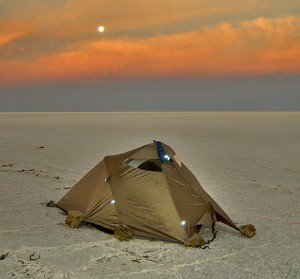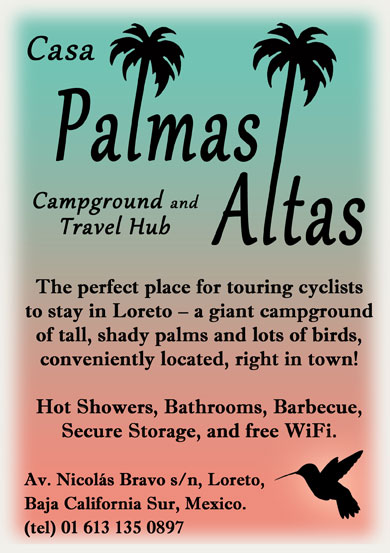Pitch Perfect: The Myth of the Perfect Campsite
Searching for a place to camp with two other cyclists in Cuba one afternoon, I discovered a near-perfect site. It was an area of dry, sheltered, level ground next to a small, clean, tree-enclosed river with a waterfall the perfect height for showers. It was out of sight and earshot of the road, yet it was easily accessible by bike. It did have a couple of drawbacks – a bit muddy near the river, and if we swam too far from the waterfall we’d sometimes pick up a small leech – but it was beautiful, secluded, and convenient and we spent three nights there, sleeping to the soothing sound of our little waterfall.
I’ve camped in other near-perfect spots in other parts of Latin America: On cliff edges overlooking mountain valleys; inside ancient ruins overrun with vines; on high-altitude salt flats with 360-degree sunsets; on white, soft beaches so secluded and warm that I stopped wearing clothes.
So, if these places were only near-perfect then what would make a campsite perfect?
My dream campsite checklist
• dry
• level
• free (obviously)
• naturally sheltered
• private
• secret (not the same as private)
• not too buggy
• not too muddy
• near fresh water
• accessible by bike
• somewhere to sit
• somewhere to hang laundry
• somewhere to lean the bike
• great weather
• an amazing view
It is, of course, almost impossible to find this campsite. In all my years of bike touring it has never happened. Usually, the perfect campsite means, the best campsite given the current situation. Weather, geography, location, and time of day all play a part in determining the best available option in any particular moment.
Sometimes, the perfect campsite is behind a gas station. Sometimes, it’s under a bridge. Sometimes it turns out to be much better than I thought it would be. Sometimes, it’s much worse. I have camped in places that were so good I decided to stay for several days. I have also camped in places so bad that I had to pack up and move in the middle of the night.
Where’s the best place you’ve camped in Latin America? Comment below.
camp: acampar; ir de camping
campsite: camping m; campamento m
spend the night: pasar la noche
tent: carpa f; tienda f de campaña
place: lugar m
path, trail: sendero m
uneven ground: terreno m desnivelado
private: privado -da
river: río m
ants: hormigas fpl
bugs: bichos mpl
view: vista f
Feature image (top of page): Camping in Uruguay in the coastal pines.
© El Pedalero, 2012.








Hi Pedalero,
do you think Santa Marta to Medellin is doable in 3 weeks? also is the route safe smooth for riding? We also want to buy/rent the bikes straight in Colombia…do you have any advice on that? You are a true source of inspiration and I think I might have some more questions along the way :-).
Thanks!
Hola Alina,
Thanks for the questions and those nice words!
I’m not too sure which route you’re thinking of (there are many possibilities), but don’t feel like you have to commit to any route you’ve planned. Things change. Roads get paved. Roads get washed out. Weather and and other “uncontrollables” force you this way and that. If you’re running low on time, hitch or bus if you have to.
I’ve never bought a bike in Colombia, but I imagine it would be no problem since cycling is the national sport of that country (or so I’m often told when I’m there). I’m sure the big cities will have something reasonable. Fancy panniers and other “techy” gear may be unavailable or expensive, but I could be wrong about that. Talk to the people in the bike shops in Bogota or Medellin and I’m sure you’ll find solutions.
Colombia is fantastic! Feel free to contact me through the contact page for further questions.
Suerte!
Hi Pedalero, what about hammocks ? Not using it ? Had a great time in Spain and Portugal cycling with hammock plus tarp.
Hey Rene!
Yeah, I’ve only rarely used the hammock. A hammock is OK when you have somewhere to string it up, but so many places I’ve toured (e.g. deserts, highlands, altiplanos) have no available trees or similar place to attach a hammock (note the photo of Salar De Uyuni above).
Also, I like having a secure, contained, bug-free area to sleep and hang out in. Plus, I often get a sore back from the hammock, but that’s just me. Others claim to get great sleeps in the hammock.
Hammocks are nice for getting off the wet ground, though. I think on a short trip in an area of many trees that’s also not too buggy a hammock can be a decent option.
Thanks for the quick answer ! I thought that hammock could be convenient when it comes to bugs but I must say I ve only experienced hammock in Europe.
Anyway your blog is a source of inspiration for me. I’ve been cycling extensively in Europe but South America is something else !
A topic that you could cover (if you are in lack of inspiration :)) is the bike transportation by plane and getting off from airport with the bike. I’ve seldom seen those aspects covered on cycling blogs. Right now I m thinking of taking a one month cycling trip in Colombia. Though I need to get there from France first. Taking a bike in a plane is expensive, dangerous (parts can be broken) and is in general stressful so for one month I wonder if it is it really worth. I wonder if it wouldn’t be a better option just to buy a descent bike in Bogota and then sell it half price before I fligh off ?
I guess that would be the campsite in the Reserva Nacional Malalcahuello-Nalcas (Chile); on flat green grass, near the lake, with a view of the Volcan Lonquimay reflected in those still waters. Quite amazing! Very tranquil!